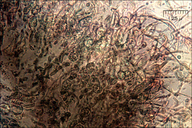|
|
click photo for larger file

Exidia pithya
Tar Spot Fungus
|
Photographer: Dr. Amadej Trnkoczy
ID: 0000 0000 0214 2077 (2014-02-26)Copyright © 2014 Dr. Amadej Trnkoczy
|
|
INFORMATION PROVIDED WITH THE PHOTO
|
date of photo Jan 11, 2014
latitude 46.37016 longitude 13.72401
View on Google Maps.
location
Lower Trenta valley, southeast slopes of Mt. Pelc, dirt forest road to Berebica, between third and fourth switchback, East Julian Alps (Posočje, Slovenia)notes Slo.: smrekova zamazanka - syn.: Exidia plana (Wigg.:Schleich.) Donk 1966 var. pithya (A. & S. 1805) Fries 1822 - Habitat: steep, rocky, southeast oriented mountain slope, light mixed forest with Picea abies, Fagus sylvatica, Fraxinus ornus, Ostrya carprinifolia, Corylus avellana dominant; calcareous ground, sunny and dry place, exposed to direct rain, average precipitations ~ 3.000 mm/year, average temperature 6-8 deg C, elevation 650 m (2.150 feet), alpine phytogeographical region. - Substratum: cut down and debarked timber of Picea abies, early initial stage of disintegration. - Comments: Taxonomy of black Exidia species is not yet agreed upon and distinguishing among them is often a difficult task. However, Exidia pithya is supposed to be an 'easy' case. Substratum (exclusively conifers), almost complete lack of glandular warts, small overall size and relatively thin fruit bodies should reliably distinguish it from other black species of this genus. Young fruit bodies are often distinctly radially wrinkled (Ref.: (4)). Microscopic traits are very variable in this genus and hence of little discriminatory power. A surprise of this observation seems to be the substratum. Namely, Ref. : (5) states for it only conifers in bark, while my observation grows directly on wood. - Growing in groups of several fruit bodies, many coalescing. Dimensions of coalescing fruit bodies up to 1.5 x 2.8 cm and only up to 2(3) mm thick. - Spores smooth. Dimensions: 13.9 [14.9 ; 16.6] 17.6 x 5.9 [6.1 ; 6.4] 6.6 microns, Q = 2.2 [2.4 ; 2.7] 2.8; N = 5 ; C = 95%, Me = 15.8 x 6.2 microns, Qe = 2.5. Arthrospore dimensions: 8,9 [11 ; 12,2] 14,2 x 4,2 [5,1 ; 5,6] 6,5 microns, Q = 1,4 [2 ; 2,4] 3; N = 20; C = 95%, Me = 11,6 x 5,4 microns; Qe = 2,2. - Basidia longitudinally septated, dimensions: 10.7 [13.6 ; 15.3] 18.1 x 6.2 [8.3 ; 9.6] 11.7 microns, Q = 1.1 [1.5 ; 1.8] 2.2; N = 19 ; C = 95%, Me = 14.4 x 9 microns; Qe = 1.6. Olympus CH20, NEA 40x/0.65, magnification 400 x, in water. AmScope MA500 digital camera. -There were only a few spores found. They are a bit too wide and surprisingly septated. I also fund many arthrospores in chains. Since I lack special literature I am uncertain that they both belong to my observation. Measured basidia dimensions fit reasonably well to data from literature; eventually they are a bit too narrow according to Ref.: (3). - Herbarium: Mycotheca and lichen herbarium (LJU-Li) of Slovenian Forestry Institute, Večna pot 2, Ljubljana, Index Herbariorum LJF - Ref.: 1) http://www.uni-tuebingen.de/uni/bbm/mycology/exidia/pithya.htm (2) http://www.rogersmushrooms.com/gallery/DisplayBlock~bid~12104~gid~~source~gallerydefault.asp 3) J. Breitenbach, F. Kraenzlin, Eds., Fungi of Switzerland, Vol.2. VerlagMykologia (1984), p 62. 4) http://forum.pilze-bayern.de/index.php/topic,565.msg5793.html#msg5793 (5) Jülich, cited in Ref.: (4) 6) A.E. Torkelsen, Nordic Macromycetes, Vol. 3., cited in Ref.:(4) (7) Neuhoff, Pilzen Mitteleuropas, cited in Ref.:(4),(8) G.J. Krieglsteiner (Hrsg.), Die Grosspilze Bade-Württembergs, Band 1, Ulmer (2000), p 100.camera AmScope MA500 digital camera
contributor's ID # Bot_781/2014_DSC9767 photo category: Fungi - fungi
|
MORE INFORMATION ABOUT THIS FUNGUS
|
| common names
Tar Spot Fungus (photographer)
View all photos in CalPhotos of Exidia pithya Check Google Images for Exidia pithya |
|
The photographer's identification Exidia pithya has not been reviewed. Click here to review or comment on the identification. |
|
Using this photo The thumbnail photo (128x192 pixels) on this page may be freely used for personal or academic purposes without prior permission under the Fair Use provisions of US copyright law as long as the photo is clearly credited with © 2014 Dr. Amadej Trnkoczy.
For other uses, or if you have questions, contact Dr. Amadej Trnkoczy amadej.trnkoczy[AT]siol.net. (Replace the [AT] with the @ symbol before sending an email.) |
|
|
